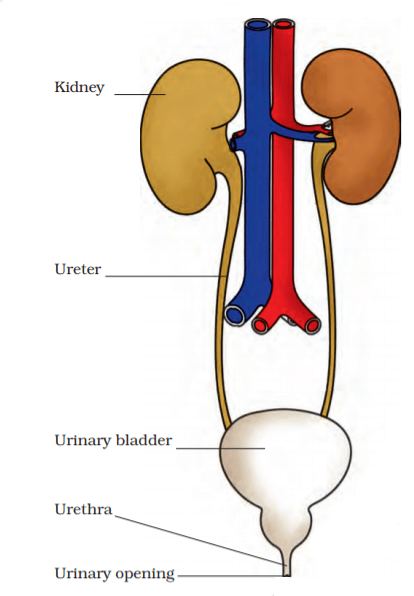Class 7 Science Chapter 7 Question Answers - Transportation in Animals and Plants
Q1: Circulatory system consists of the heart, blood vessels and _____________.
Ans: Blood.
Q2: Name the system in the body responsible for the removal of unwanted harmful substances and excess water in the body cells.
Ans: Excretory system
 Excretory System
Excretory System
Q3: Name the fluid part of blood.
Ans: Plasma
Q4: Name the three types of cells present in the blood.
Ans: White blood cells, red blood cells and platelets
Q5: Red blood cells, also called RBCs, have iron pigments known as _____________.
Ans: Haemoglobin
Q6: The presence of haemoglobin gives red colour to blood. True/ False.
Ans: True
Q7: White blood cells, or WBCs, defend the body against ___________________.
Ans: Infection
Q8: When a blood vessel is cut, blood comes out immediately. After some time, a dark red clot is formed on the cut. Name the cell responsible for this.
Ans: Platelets
Q9: Name the two types of blood vessels
Ans: Arteries and vein
Q10: Which of the two carry oxygen-rich blood, arteries or veins?
Ans: Arteries
Q11: A number of capillaries together form a ___________
Ans: Vein
Q12: Where is the heart located in the human body?
Ans: The heart is located in the chest cavity with its lower parts towards the left.
Q13: Name the vein in the body that carries oxygen-rich blood.
Ans: pulmonary vein
Q14: Pulmonary artery, the only artery in the human body that carries carbon dioxide-rich blood. True/ False.
Ans: True
Q15: What is heartbeat?
Ans: The muscles of the heart contract and relax, which constitutes a heartbeat.
Q16: What is pulse?
Ans: Throbbing that occurs in arteries due to flowing of blood is called pulse or the flow of blood in an artery over a bone is called the pulse.
Q17: The normal pulse rate is
- 70 to 90 per minute.
- 70 to 80 per minute.
- 40 to 70 per minute.
- 70 to 100 per minute.
Ans: 4. 70 to 100 per minute.
Q18: What is removed along with water as sweat?
Ans: Extra salts are removed along with water as sweat.
Q19: What is the function of valves present in veins?
Ans: Valves are present in veins to prevent backflow of blood in tissues.
Q20: Name the term for the transport of food from leaves to other parts of plants
Ans: Translocation
Q21: Name the type of blood vessels which carry blood from organs to the heart.
Ans: Veins
Q22: Name the waste products formed in the body.
Ans: Urea, uric acid and excess water.
Q23: Define excretion.
Ans: The removal of waste products is termed excretion.
Q24: Name organs of the excretory system.
Ans: Kidneys, the ureters, the urinary bladder and the urethra.
Q25: Sweat makes the body warm and it helps to maintain normal temperature. True/ False
Ans: False
Q26: What is osmoregulation?
Ans: Osmoregulation is the regulating osmotic pressure of the body fluids by controlling the amount of water and salts in the body.
Q27: Heart pumps carbon-dioxide-rich blood to______________and oxygen-rich blood to rest of the __________.
Ans: Lungs and body
Q28: The roots of the plants remain in contact with underground water.True/ False
Ans: True
Q29: What does the xylem transport?
Ans: Xylem-water and minerals
Q30: What does the phloem transport in plants?
Ans: Phloem- prepared food.
Q31: Vena cava transport oxygenated blood or deoxygenated blood?
Ans: deoxygenated blood
Q32: The Transpiration process helps eliminate extra water from plants.True/ False
Ans: True
Q33: Arteries and veins are joined by a network of ___________________.
Ans: Capillaries
Q34: Kidney eliminates the waste material in the liquid form called as__________________.
Ans: Urine
Q35: Name the instrument used to measure blood pressure.
Ans: Sphygmomanometer
|
111 videos|286 docs|28 tests
|
FAQs on Class 7 Science Chapter 7 Question Answers - Transportation in Animals and Plants
| 1. What are the main types of transportation in animals? |  |
| 2. How do plants transport water and nutrients? |  |
| 3. What is the role of the heart in animal transportation? |  |
| 4. How does osmosis relate to transportation in plants? |  |
| 5. What adaptations do animals have for efficient transportation? |  |

















